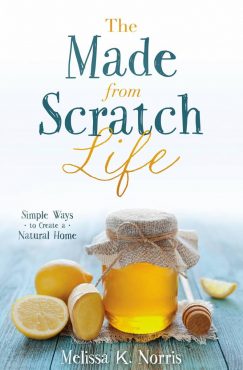 Many of today’s cleaning products, from what we use to clean our homes to our bodies, contain dangerous chemicals. We shouldn’t have to worry about what we’re using to clean things as much as the items we’re cleaning.
Many of today’s cleaning products, from what we use to clean our homes to our bodies, contain dangerous chemicals. We shouldn’t have to worry about what we’re using to clean things as much as the items we’re cleaning.
The pioneers didn’t have aisles of cleaning and personal care products to choose from. They used simple ingredients to meet all of their cleaning needs.
In our homes and lives, there are so many dangerous things and we don’t realize the harm until the damage is done. We can wear gloves and hope we’re protected, but we’d really be better off if we never came into contact with it all.
After I had children, my concern with all the chemicals used in our homes and lives really weighed on me. Walk down any cleaning aisle at a grocery store, and there are scores of different products all claiming to keep our homes clean. But upon closer inspection they’re riddled with warnings and precautions. The list of what to do if they come in contact with your skin makes me question using them in the first place.
When my children were infants and learned to crawl, I suddenly reexamined my entire home from a different level. I crouched down and viewed my home from the floor. No dangling items remained, heavy things within grasp were removed, and the cleanliness of my floors mattered more.
I remembered how my hands had burned and hurt for days after using the oven cleaner. Typically, we don’t walk around on our hands and knees. But babies have this neat habit of putting not just their hands in their mouth, but also their feet. This really got me to thinking.
Did I want my children’s sensitive skin to come in contact with these cleaners?
Nope. Nada, not one bit. Was I going to stop cleaning my home? No.
I began looking into natural cleaners. I knew my great-great grandparents hadn’t browsed the aisles at the general store for their favorite brand of cleaner. What had they used?
There are two natural ingredients most of us have already that can be used to clean just about every surface of our homes. You use them in your kitchen and your food on a frequent basis already. Vinegar and baking soda. These two have become a staple in my home and cleaning closet.
For cleaning, I usually use white vinegar, but I always have raw apple cider vinegar on hand for cooking and health reasons. Whichever you happen to have can be used.
White vinegar is usually a bit cheaper, so I like to use it for cleaning. Here are some of my recipes for using vinegar and baking soda to clean. The more attention I give to labels and ingredients lists, the more things I end up making at home.
From-Scratch Cleaning Window Cleaner
Take a spray bottle, fill it a quarter of the way with vinegar, and then top off with water. I’ve used this cleaner with paper towels and washable rags, and it cleans my sliding glass door, the mirrors and all the windows without a single streak.
Some people don’t particularly like the scent of vinegar while cleaning. As it evaporates, the smell leaves, but if you want your cleaner to smell a little bit better, you’ll want to try this next recipe.
Homemade Citrus All-Purpose Cleaner
- 4 to 5 citrus peels
- 3 cups white vinegar
Fill a quart-size canning jar three quarters full with your lemon peels. Pour white vinegar over the lemon peels. Let it set for a minute and then top off with more vinegar. Completely submerge the lemon peels.
Cover with a lid and band and set in a dark cupboard for two weeks. Shake the jar every few days. You might want to mark the top of the lid with the date in case you forget.
In two weeks, pour the vinegar through a strainer or cheesecloth. Dilute with two parts water to one part lemon vinegar. Use on windows, countertops and mirrors, and as a general multipurpose cleaner. You can use any citrus fruit or add some herbs for your own unique, custom blend. If you don’t have any citrus peels, you can add 10 drops of your favorite lemon or orange essential oil.
Floor Cleaner
Ever notice small, dark spots in the divots of your linoleum?
Over time, soap builds up and dirt sticks to it. Using vinegar eliminates these spots.
If you have little ones or pets, you won’t have to worry about harsh chemicals where they play. Add a cup or so of vinegar to your bucket or sink full of water. No soap. Use to mop your hardwood, laminate, tile or linoleum. (It is not recommended to use acid-based cleaners, such as vinegar or citrus, on limestone and marble.)
Laundry
Add 1/4 cup vinegar to your laundry instead of bleach. It will kill odor-causing bacteria and clean your washing machine with no discoloring. I toss mine into the liquid softener dispenser.
Drain Declogger
Vinegar is also an awesome way to unclog drains. Pour 1/8 to 1/4 cup of baking soda down your drain. Follow it with a chaser of vinegar. I pour until it reaches a good foam, allow it to foam for a few seconds, and chase it again with more vinegar. Let your drain sit for 10 to 15 minutes. Pour a cup of boiling water down the drain.
For an especially clogged drain, repeat. I do this every other month or so to keep pipes clear.
If you’re having fruit fly troubles, this can clear up the problem. Fruit flies often lay eggs in your sink pipe. This will kill any eggs and help eliminate those pesky buggers.
Carpet Cleaner
Dampen stains with the vinegar and water cleaner (test a small area first for discoloring).
Blot up with a rag. If carpets have an odor, sprinkle baking soda over carpet, let sit for 15 minutes, and then vacuum.
Faucets
Wet a towel in vinegar. Wrap it around the faucet and handles and let sit for a half hour — or until you walk back in the room and remember you were cleaning, whichever comes first.
Come back and wipe clean. Hard water stains and gunk will be gone.
Shower and Bathtub
I use baking soda to scrub the bottom of our shower and the tracks of our shower door. After rinsing off the baking soda, I spray all the surfaces with my vinegar rinse. I let it sit for a few minutes and then wipe clean.
Sinks
Sprinkle baking soda into your sink. Mix with a small amount of water to make a paste and scour the sink. It eliminates odor and rubs off stains. Rinse clean with warm water.
Toilets
Dump 1/2 cup baking soda into the toilet bowl. Let it sit for about 15 minutes. Scrub with brush. This takes away any odor and scours off anything undesirable. Spray toilet seat, handle and base with the homemade all-purpose citrus cleaner and wipe clean.
Dirty Dishes
Ever have baked-on food stuck in your pans? Liberally sprinkle on baking soda. Use the baking soda to scour off baked-on food. It absorbs the grease as you scrub. I’ve found this works best with a dry pan and no added water.
I use mostly cast iron for our cookware. Because soap can ruin a good seasoning, I use a salt scrub to remove cooked-on food. Sprinkle a few tablespoons of salt onto the cast iron and scrub. Dump soiled salt into the garbage and then rinse with hot water. Dry and lightly oil the cast iron before putting away.
Natural Oven Cleaner
Knowing firsthand what commercial oven cleaners can do to the skin, I was determined to never use them again. But when we were having Thanksgiving at our home, I couldn’t leave my oven in its current state of messiness. Nothing makes me give my house a good cleaning like having company over. (I’m not sure if this means I should invite people over more often or clean my house more. Either way, I can get a month of Saturday cleanings done in a few hours if company is on the way.)
This method works extremely well and requires a small amount of elbow grease. Liberally sprinkle baking soda on the inside of your open oven door. Scrub with a dry rag or even your fingertip. It’s safe and won’t harm your skin. The dry baking soda absorbs the grease, and the grit lifts it off. I tried it with water and it didn’t work as well as the dry method for me.
Especially soiled spots may need another dousing of baking soda. Apply to the bottom of the oven. I did have to make a light paste with baking soda and water for the sides and top of the oven, but they usually don’t have as much baked-on gunk.
Taken from: "The Made from Scratch Life." Copyright 2016 by Melissa K. Norris. Published by Harvest House Publishers, Eugene, Oregon. www.harvesthousepublishers.com Used by permission.




























